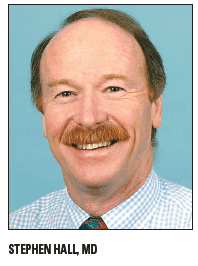Canada Sees Mixed Trends in Thyroid Cancer
TORONTO-Two large, population-based studies with over 35 years of data revealed some of the factors that have influenced the incidence of thyroid cancer. Two key findings: Canadian men and people living in rural areas generally present with more advanced disease and the incidence of anaplastic thyroid cancer is waning. The studies were presented at the 2009 World Congress on Thyroid Cancer.
TORONTO-Two large, population-based studies with over 35 years of data revealed some of the factors that have influenced the incidence of thyroid cancer. Two key findings: Canadian men and people living in rural areas generally present with more advanced disease and the incidence of anaplastic thyroid cancer is waning. The studies were presented at the 2009 World Congress on Thyroid Cancer.

In the province of Ontario, men and patients who live in rural areas tend to present with larger thyroid tumors, according to a study led by Stephen Hall, MD, an otolaryngologist at Queen’s University in Kingston, Ontario. The study described the patients, the tumors, the surgical procedures, and the surgeons who treated differentiated thyroid cancer in the province from 1990 to 2002.
The study population consisted of 3,500 differentiated thyroid cancer patients from urban, suburban, and rural regions. Data sources included records from the Ontario Cancer Registry and the Cancer Research Institute at Queen’s University (oral session 3).
Dr. Hall reported that the number of differentiated thyroid cancers increased in the 12-year period. Most patients had tumors that were smaller than 1 cm or tumors that were between 2 and 4 cm; few patients had tumors larger than 4 cm. Patients who lived outside of Toronto, which is the most densely populated area of the province, tended to present with tumors larger than 2 cm. If they lived in a rural area-four of the seven regions in Ontario are designated as rural-they presented with still larger tumors. “This comes as no great surprise. This has to do with access to imaging and patient demand,” Dr. Hall said.
In most cases, initial treatment consisted of total thyroidectomy. The extent of surgery was influenced by gender, with total thyroidectomy performed more often in males than in females. However, age did not make a difference: the percentages of total thyroidectomies and partial thyroidectomies were the same for younger and older patients.

Tumor size was also a factor in the extent of surgery, although not to the degree that the investigators were expecting. Although most patients had a total thyroidectomy regardless of their tumor size, almost 60% of patients with tumors smaller than 1 cm had a total thyroidectomy. This percentage was roughly the same in patients who had tumors that were larger than 4 cm.
Meanwhile, in Manitoba, Ontario’s neighbor to the west, the incidence of anaplastic thyroid cancer has dropped, possibly as a result of iodine supplementation in the diet and less multinodular goiter. However, Hrthle thyroid cancer incidence has gone up.
Data from the Canadian Cancer Statistics showed a 100% nationwide increase in the incidence of thyroid cancer in males and a 90% increase in females in recent years, while mortality rates increased in males by 0.7% but were reduced by 1.5% in females, reported K. Alok Pathak, MS, DNB, an associate professor in the department of surgery at the University of Manitoba Faculty of Medicine in Winnipeg.

Dr. Pathak’s study looked at 1,702 consecutive thyroid cancer patients seen in Manitoba from 1970 to 2005. The median follow up was 152 months. The majority of patients (75%) were female, with a mean age at diagnosis of 48 years. Most patients had stage T1 or T2 disease, and 74% were node-negative at the time they presented. Only 4% presented with distant metastases. During the later part of the study period (2000-2005), 366 thyroid cancers were seen vs 160 earlier in the study (1970-1975). However, the five-year disease-specific survival steadily improved between 1970 and 2005, from 75.7% to 95%.
Also, the proportion of undifferentiated cancers fell from 19.4% (1970-1975) to 5.5% (2000-2005). Differentiated thyroid cancer accounted for almost 90% of all thyroid cancer cases in Manitoba. There was an increase in incidence of Hrthle cell cancer and a decrease in anaplastic thyroid cancers. Multivariate analysis showed that disease-specific survival was independently influenced by tumor histology and grade (hazard ratio [HR] = 26.1; P = .005), completeness of resection (HR = 82.9; P = .020), and age at diagnosis (HR = 1.1; P < .001). “In thyroid cancer, pathology is the determinant of successful outcome,” Dr. Pathak said. “In low-risk thyroid cancer, which represents 90% of our thyroid cancers, adequate surgery is more than enough; you don’t need to give adjuvant treatment for that. I think that is the important message.”